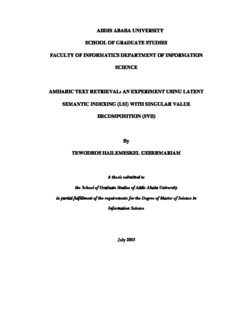Table Of ContentADDID ABABA UNIVERSITY
SCHOOL OF GRADUTE STUDIES
TRADE LIBERALIZATION AND ECONOMIC GROWTH
IN ETHIOPIA: ABOUND TEST APPROACH
BY
ADDIS ASSEFA
A PROJECT SUBMITTED TO THE SHOOL OF GRADUATE STUDIES OF THE
ADDIS ABABA UNIVERSITY IN PARTIAL FULFILLMENT OF THE
REQUIREMENTS FOR THE DEGREE OF MASTERS OF ARTS IN APPLIED
TRADE POLICY ANALYSIS
JUNE, 2008
A C K N O W L E D G E D E M E N T S
First of all I would like to express my heart felt thanks to my advisor Dr.
Girma Estiphanos for his guidance.
My special thanks also go to Dr. Abi for his constructive comment and
guidance since the beginning of the paper work. I am also grateful to Alem
for his comment.
Special thanks are also extended to Befekadu, Tefera Abebe, Danial
Desalegn, Danial Hailu, Getu Bayesa and all my friends who directly or
indirectly provide me with normal support and encouragement during the
study.
i
TABLE OF CONTENTS
Page
A C K N O W L E D G E D E M E N T S .....................................................i
LIST OF TABLES ............................................................................ ..............v
LIST OF FIGURES........................................................................................vi
LIST OF APPENDICES................................................................................ vii
ACRONYMS AND ABBREVIATIONS ........................................ ..............viii
ABSTRACT...................................................................................................... ix
CHAPTER ONE: INTRODUCTION ..........................................1
1.1 Backgrounds ..............................................................1
1.2 Statement of the problem........................................ 4
1.3 Objective of the study.................................................. 6
1.4 Significance of the study.......................................... 7
1.5 Scope and limitations of the study......................... 8
1.6 Organization of the study......................................... 8
CHAPTER TWO: SURVEY OF LITERATURE........................10
ii
2.1 Theoretical frame work...........................................10
2.2 Empirical literatures.................................................15
CHAPTER THREE: MACROECONOMIC PERFORMANCE..........24
3.1 An overview of economic growth of Ethiopia.......................24
3.2 Ethiopia's external trade policy.....................................................33
3.3 The performance of foreign trade ..............................................38
CHAPTER FOUR: THE DATA AND METHODOLOGY...............41
4.1 Data sources...................................................................................41
4.2 Model specification........................................................................41
CHAPTER FIVE: THE ANALYSIS OF EMPIRICAL RESULTS.......52
5.1 Stationary tests......................................................................................52
5.2 Bound test for co integration............................................................53
5.3 The stability and diagnostic test.......................................................59
iii
CHAPTER SIX: CONCLUSION AND POLICY IMPLICATIONS..........62
6.1 Conclusion...............................................................................................62
6.2 Policy Implications................................................................................63
Bibliography............................................................................................................64
Appendices........................................................ ............................................68
iv
LIST OF TABLES
Page
Table 3.1 Sectoral Output and Real GDP............................................. .................26
Table 3.2 The Share of Major Export.................................. .................................. 27
Table 4.1 Six Possible Testable Hypotheses between Openness and Growth..51
Table 5.1 ADF and PP Unit root Test Results.......................................................53
Table 5.2 Bound Test for Co-integration Analysis Based on Equation (4).......54
Table 5.3 The Critical Values of the Upper and Lower Bound...........................55
Table 5.4 Estimated Long runs Coefficients using ARDL Approach................55
Table 5.5 Short run Error Corrections Elasticity Estimates.................................57
Table 5.6 Diagnostic Tests Results.........................................................................61
iv
LIST OF FIGURES
Page
Fig.3.1 The share of Coffee, Oilseeds and Chat Export, 2000/01-2005/06............27
Fig.3.2 Trade Openness, 1960-2000................................................................................40
Fig.5.1 Plots of Cusum and Cusumq for Coefficients Stability for ECM Model.....61
Fig.5.2 Graphical representation of an impulse response functions...........................62
v
LIST OF APPENDICES
Page
Appendix .1 The Broad Economic Policies....................................................70
Appendix .2 Trade Openness Series, 1960-2000............................................71
Appendix .3 Graphical Unit root Test for the First Difference
and Levels of the Variables.........................................................72
v
ACRONYMS AND ABBREVIATIONS
ADLI Agricultural Development Led Industrialization
AIC The Akaike’s Information Criterion
ARDL-ECM Auto Regressive Distributed Lag Error Correction Model
CUSUM The Cumulative Sum
CUSUMQ The Cumulative Sum of Squares
DC Developed Country
ELG Export Lead Growth
EPRDF Ethiopian People Revolutionary Democratic Front
FDI Foreign Direct Investment
GATT General Agreement on Tariffs and Trade
GDP Gross Domestic Product
GNP Gross National Product
ISI Import Substitution Industrialization
LDC Least Developing Country
LF Labour Force
MoFED Ministry of Finance and Economic Development
NBE National Bank of Ethiopia
OLS Ordinary Least Squares
OPEN Trade per real GDP
PASDEP Plan for Accelerated and Sustained Development to End Poverty
RER Real Exchange Rate
RGDP Real GDP per Capita
SAP The Structural Adjustment Program
SBC The Schwarz Bayesian Criteria (SBC)
UECM Unrestricted Error Correction Model
VAR Vector Auto Regression
VECM Vector Error Correction Model
WTO The World Trade Organization
viii
ABSTRACT
The purpose of the study is to analyze the relationship between Ethiopia's
economic growth (RGDP) and trade liberalization (OPEN), using the time
series data during 1971/72-2003/04. In the estimation of the long run and
the short run relationships among the variables, the newly developed
ARDL-ECM bound test procedure (Pasaran, 2001) is employed. This
approach is capable of testing for the existence of a long run relationship
regardless of whether the underlying time series are individually I(0) or I(1)
or whether the underlying time series are mutually I(1) or I(0). This
enhanced the stability and robustness of our results. Accordingly, the
results indicate that there exist a long run relationship between real GDP
per capita and openness (trade/GDP). The long run estimated coefficient
suggests that the impact of trade liberalization on economic growth has
positive and significant but others variables real exchange rates (RER) and
labour force (LF) are insignificant impact on real GDP per capita. Further,
the feedback coefficient indicate that a very high rate of adjustment
towards long run equilibrium. The CUSUM and CUSUMQ stability test
also indicate that the estimated long run coefficients remain stable over the
period of the study. Since trade liberalization is the long run process, from
the study we can suggests that in order to enhance growth the country
should continuing liberalize their trade.
ix
Description:AMHARIC TEXT RETRIEVAL: AN EXPERIMENT USING LATENT .. Figure 3.3 Average recall-precision graph for two indexing methods74 . appear in the query, meaning that many of the query vector components are zero in Amharic language, concept based retrieval systems, such as LSI retrieval

